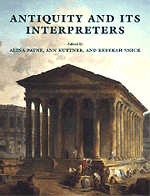Freshly Printed - allow 8 days lead
Couldn't load pickup availability
Antiquity and its Interpreters
First published in 2000, Antiquity and its Interpreters examines how the ancient Romans were viewed by early modern Italians.
Alina Payne (Edited by), Ann Kuttner (Edited by), Rebekah Smick (Edited by)
9780521594004, Cambridge University Press
Hardback, published 13 February 2000
340 pages
28.8 x 22.4 x 2.7 cm, 1.46 kg
"...this volume makes a significant contribution to our efforts to comprehend the past. It offers...important new perspectives and insights on the physical and textual remains of antiquity and their reception by artists, architects, and writers from medieval to modern times." Sixteenth Century Journal
This book was first published in 2000. Antiquity and its Interpreters examines how the physical and textual remains of the ancient Romans were viewed and received by writers, artists, architects, and cultural makers of early modern Italy. The importance of antiquity in the Renaissance has long been acknowledged, but this volume reconsiders the complex relationship between the two cultures in light of recent scholarship in the field and a new appreciation and awareness of the act of history writing itself. The case studies analyze specific texts, the archaeological projects that made 'antiquity' available, the revival of art history and theory, the appropriation of antiquities to serve social ideologies, and the reception of this cultural phenomenon in modern historiography, among other topics. Demonstrating that the antique model was itself an artful construct, Antiquity and its Interpreters shows that the originality of Renaissance culture owed as much to ignorance about antiquity as to an understanding of it. It also provides a synthesis of seminal work that recognizes the reciprocal relationship of the Renaissance to antiquity.
Introduction
Part I. Inhabiting History: 1. Historical self-definition
1.1 Imitation James Ackerman
1.2 P. Petrarch and the broken city David Galbraith
1.3 Acquiring a classical past: historical appropriation in Renaissance Venice Patricia Fortini Brown
1.4 Ordering history and style: Georgio Vasari on the art of history Philip Sohm
2. Historical continuities
2.1 Renaissance and real estate: the medieval afterlife of the Temple of Diana in Nimes Sheila Bonde
2.2 Imaginary architecture and antiquity: the fountain of Venus in Francesco Colonna's Hypnerotomachia Poliphili Martine Furno II
2.3 Antiquity consumed: transformations at San Marco, Venice Marina Belozerskaya and Kenneth Lapatin
Part II. Cultural Pursued: 3. The heritage of Zeuxis: painting, rhetoric and history Leonard Barkan
3.1 Mind's passion: conjugating rationality and sensuality in neo-platonic interpretations of Italian Renaissance art Julia Branna Perlman
3.2 The transformation of ancient landscape through the ideology of Christian reform Nicola Courtright
4. The (re)emergence of the aesthetic
4.1 Ut poesis architectura: Gherardo Spini and Italian archietectural criticism circa 1570 Alina Payne
4.2 Viewing the art of Michelangelo: visual metaphor in the art critical tradition of the Renaissance Rebekah Smick
4.3 The body and antiquity in Alberti's art theoretical writings Gerhard Wolf
4.4 Patterns of transumption in Renaissance architectural theory Christof Thoenes
Part III. Culture Produced: 5. Textual exegesis
5.1 Pliny's laocoon? Michael Koortbojian
5.2 Symmetry and eurythmy: classical theory in architecture from Vitruvius to Bernini to the present day Tod Marder
6. Appropriation contexts: decor, Furor Bacchicus, Convivium Phyllis Pray Bober
6.1 Si come dice Vetruvio: images of antiquity in early Renaissance theory of architecture Richard Betts
Part IV. Coda: 7. Antiquity and the Renaissance from the outside
7.1 Remaking antiquity in eighteenth-century Seville Catherine Wilkinson Zerner
7.2 Winckelmann and Warburg: contrasting attitutudes toward the instrumental authority of ancient art Richard Brilliant
7.3 Figural speculations Michael Ann Holly
7.4 Writing history, viewing art: the question of the humanist's eye Carl Goldstein.
Subject Areas: History of art & design styles: c 1400 to c 1600 [ACN]


